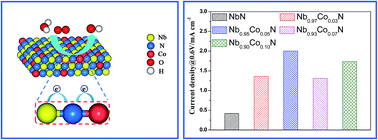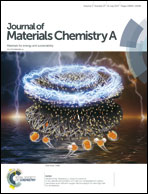A Co-doped porous niobium nitride nanogrid as an effective oxygen reduction catalyst†
Abstract
Transition metal nitrides have recently attracted significant interest as electrocatalysts for the oxygen reduction reaction (ORR) owing to their low electrical resistance and good corrosion resistance. In this paper, we describe the preparation of a Nb-based binary nitride material with a porous nanogrid morphology/structure. The catalyst exhibited good catalytic activity and high stability towards oxygen reduction. We also intensively investigated the effect that doping with a second transition metal had on the performance of the catalyst. We found that the ORR activity of NbN could be enhanced significantly by enriching the d electrons of Nb through doping with a second transition metal, and that doping with cobalt resulted in the best improvement. Our optimal catalyst, Nb0.95Co0.05N, had an ORR activity ∼4.6 times that of NbN (current density @ 0.6 V vs. the RHE). XPS results revealed that Co doping increased the proportion of Nb in a low-valence state, which may be one of the most important reasons for the enhanced performance. Another important reason is the high surface area resulting from the porous nanogrid morphology. As transition metal doping is an attractive way to enhance the activity of nitride catalysts, our work may provide an effective pathway to achieve this.



 Please wait while we load your content...
Please wait while we load your content...